If you would like to get email notices when a new list appears, send your email address. No other details are necessary.

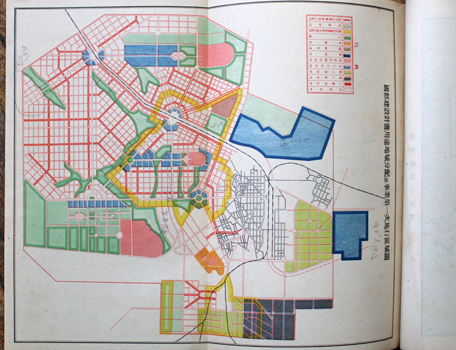
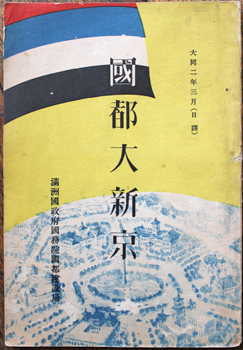
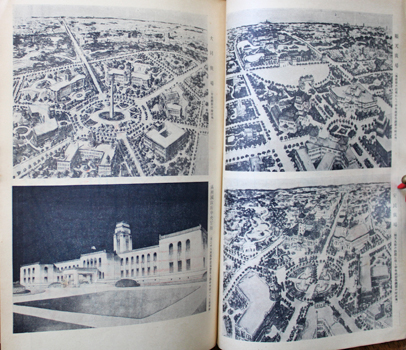
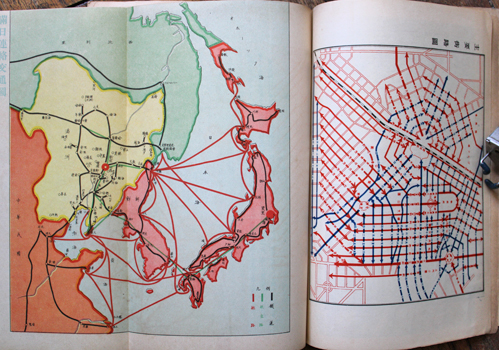
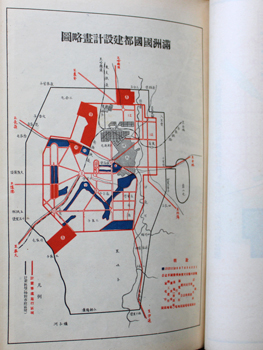

City Planning. Xinjing or Shinkyo (Changchun) - Manchukuo. 國都大新京 [Kokuto Dai Shinkyo]. Shinkyo, Manshukoku Kokumuin Kokuto Kensetsukyoku 1933. 22x15cm publisher's illustrated colour wrapper; 4,26pp, three folding plans (two colour), two other colour plans, b/w illustrations on two pages. Natural browning of the text paper, signs of use, pretty good. sold
In many ways the new capital of Manchukuo was - is - a planner's dream. Here was an empire building militaristic government wanting to both experiment with all that had been learned about city planning and show the west that not only could they do it, but do it better.
Changchun, a hybrid Chinese-Russian-Japanese railway town, was appointed the new capital, it was renamed, a five year plan for a new city was drawn up under the guidance of Professor Riki (or Toshikata) Sano in 1932, a quick compromise with a competing plan was made, and building was underway in early 1933.
Local interests (ie the Chinese and Manchu population) and business were allowed notional input but the brief was clear: social theory, technology and architecture that made for an efficient colonial capital could be put into place, local self-interest could not. Of course it was not so simple. This was to be a pan-Asian showcase, superior to western, especially colonial western, models - not equal. Confucianism, traditional ritual and Asian racial harmony were to be a central part of the city. What more could any urbanist ask for?
Students of the plan might like to start with Yishi Liu's 2011 doctoral thesis, 'Competing Visions of the Modern;' where Burley Griffin's Canberra plan and Griffin's diagrams for road classification are illustrated beside Xinjing's. By 1937, when the city was declared open, a lot of what was planned here had been scaled back and a lot was still dust and open space but, by the gods, whatever else they learnt from Canberra - and it was a lot - about planning a city, the Shinkyo planners certainly learnt how not to build a city.
Worldcat finds no copies outside Japan.
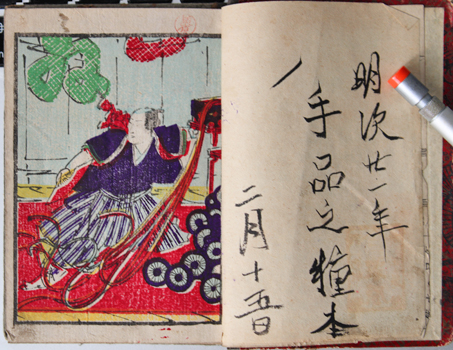
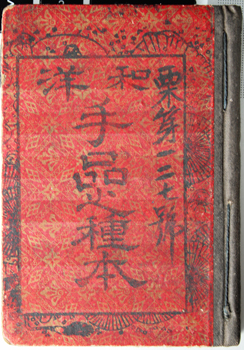
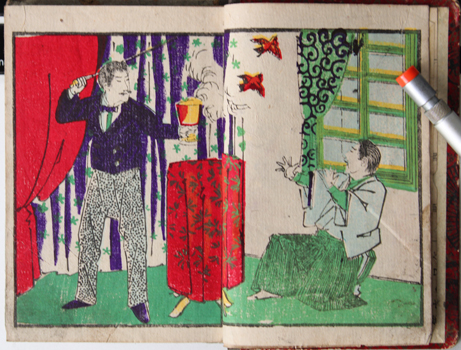
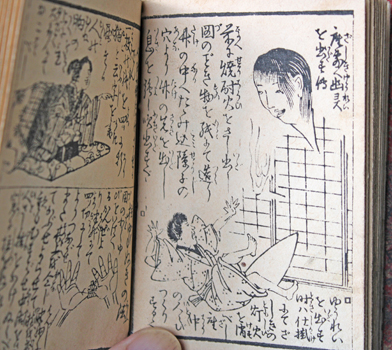
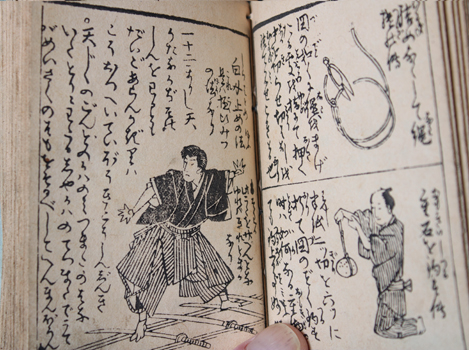

Magic. 和洋 : 手品之種本 [or 手品之種本 : 日本西洋?] [Wayo : Tejina no Tanehon]. Tokyo, Keikikaku 1886 (Meiji 19). 12.5x9cm publisher's cloth backed decorated boards printed in black; 22 double leaves including the frontispieces and the colophon leaf; one full page and one double page colour woodcut, small illustrations through the text. Smudges, plenty of signs of use - including inked inscriptions on the covers - but nothing serious. A pretty good copy of a vulnerable little book. The first endpaper is a printed scrap from another work. sold
A rare little guide to Japanese and Western magic tricks. The second title given above is from the NDL entry but, for once, I'm not convinced. If it is taken from the copy illustrated online then I think that has been rebound and the title label is not original. It's certainly a mess of a copy with duplicate leaves bound all over the place. I think the 'wayo' at the top of our cover title is printed but it does collide with the inked inscription running down the right. In any case both subtitles mean the same thing: Japanese and Western.



CLARKE, Marcus.. Long Odds. Melbourne, Clarson Massina 1869. octavo publisher's blue cloth blocked in gilt and black; eight wood engravings by Thomas Carrington. Minor blotches and smudges to the covers, signs of use, quite a good copy. Au$975
First edition of Clarke's first novel, previously serialised in his own 'Colonial Monthly' (a short lived venture). "A wretched tale of folly and baseness" but not quite a thriller in the modern sense - the murder, after all, happens near the end of the book. It would not be out of place though in a shelf of sensational novels. Clarke purposely avoided writing a novel set in Australia, preferring to explore what was to become a popular genre - the young colonial 'back home' - carving a new destiny out of the wilds of London and the counties.




Borraginol poster. ボラギノール : ぢ痔に [Borraginal : Dji Ji Ni]. Osaka? Takeda (c1930?). Colour printed poster on light cotton (muslin? calico?), 117x86cm. Rumpled and some marks but rather fresh and bright. Au$200
As made clear, piles need make no inroads in a man's life, habits and comforts. Borraginol, a still made hemorrhoid treatment, was Japan's first scientific/chemical treatment developed in 1921 at Kyoto University. Posters printed on fabric - rather than banners or flags - must be pretty uncommon, no? So what was the purpose?





Paper. Toyosha? 新発明 軽便紙 [Shin Hatsumei Keibenshi]. n.p. [Osaka?] [188-?]. 75x28cm woodcut with added colours. Piece from the top margin well away from the printing, a repaired tear; Quite good for a cheap, vulnerable bit of production. Au$150
I believe this to be an announcement for a new invention of a lightweight paper. I hope not the paper this is printed on which seems heavy and coarse to me. Probably not considering the easy grasp of our newspaper addict. I suspect the cigarettes will stay on that side of his mouth until his left eye looks as sore as the right does now. Then he will switch back. And I wouldn't be surprised to find this is the model for the previous poster, forty years younger.

LOUDON, J.C. An Encyclopaedia of Cottage, Farm, and Villa Architecture and Furniture; .. a new edition; London, Longman &c 1836. Stout octavo contemporary green gilt calf (edges a bit rubbed, a small and inoffensive flaw in the back hinge); xx,1138pp, hundreds of wood engraved illustrations and plans. Quite a handsome copy. Au$975
Probably the fourth edition, and probably much the same as the 'new edition' of 1835, both claiming numerous corrections and re-engraved plates. This refers to the original litho plates that had already disappeared from many copies of the first edition, replaced by wood engravings. Only the first edition had the imprint of Howe in Sydney and Melville in Hobart but nonetheless this book, in all its editions, was the most used architecture book in Australia during the middle of the 19th century.
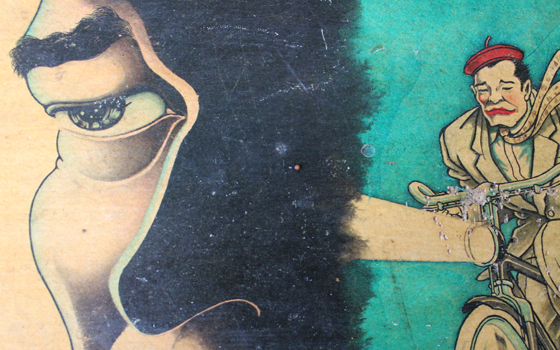
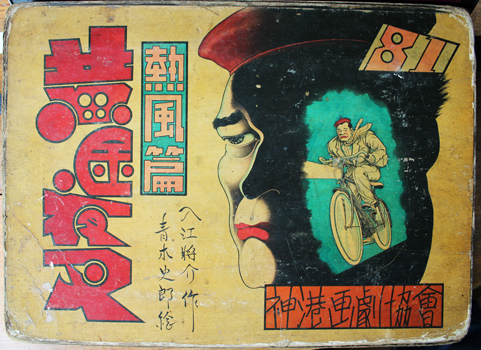
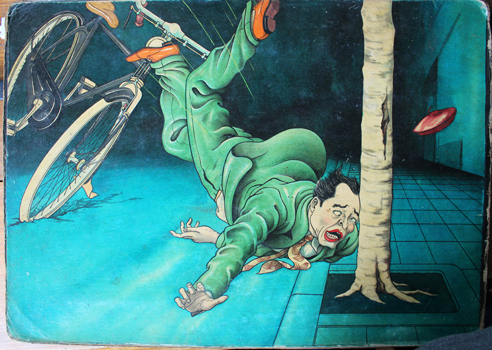
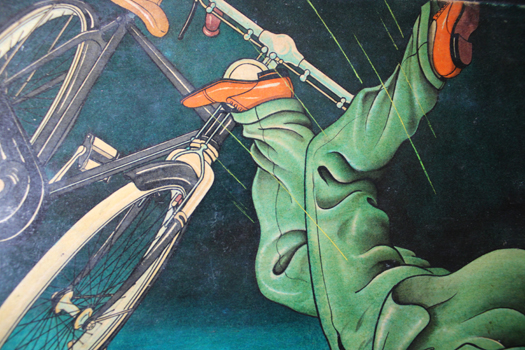
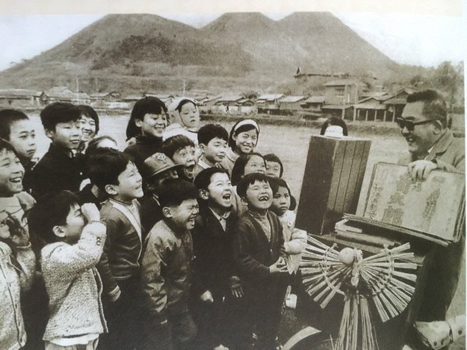

The greatest noir film never made
Street kamishibai. Irie Masayuki & Aoki Shiro. 黄金夜叉 81 熱風篇 Kogane Yasha 81 Neppu Hen n.p. Shinko Gageki Kyokai (194-?). Eight handpainted and varnished heavy boards, 25x35cm. Text handwritten on the back. Edges worn and minor scrapes and blemishes as expected. Au$5000
If you've looked at published kamishibai and wondered how it could ever have been popular ... it wasn't. The published stuff was almost all heavy handed propaganda and improving drivel produced without any artistic skill or imagination by government and education agencies and pressed on children in schools. Real street kamishibai was produced by hand by the kamishibai men themselves or by associations - such as the Shinko Gageki Kyokai - that acted more or less as lending libraries. Which is not to say that a hell of a lot of street kamishibai wouldn't be described kindly as 'naive'. But enough had to be compelling to bring and keep audiences. Specially through hundreds of episodes, which some stories ran for.
Kamishibai was not long lived. It was more or less born with cinema and died with television, and the greatest works, as far as they have survived, were produced toward the end, during the occupation after the war. The connection to film serials is inescapable of course but kamishibai is not burdened with technical restraints. If you can imagine it, you can draw it and you can tell the story.
The greatest of them all, without doubt, is the Golden Yasha. Irie, the writer, and Aoki, the artist, both worked on other stories and some of them are fabulous but everything came right with this weird gangster noir. The attention and care show that they knew they were doing something great - it's way beyond what was needed to tell a story from the back of a bike to a bunch of kids. At first I though most of it was airbrushed but, peering with a lupe, I'm now less convinced. Much seems to be washes of ink done by brush. I'm yet to see another kamishibai with this amount of careful detail. If you want to see what happens when a master of the fine brush has fun have a close look at those eyebrows and moustaches.
I have no idea how many episodes were produced, nor how many survive. I have enthusiastically chased the Golden Yasha for a few years, since I first saw a fragment come up for sale, and have traced a few episodes between episode 70 and this episode 81. All seem to have come from the same source but no more have appeared for some time.
Neither can I help with the story. The character on the bike is one of a pair of goons fleeing for his life after seeing his partner killed on the street. The young woman has spent every episode I've seen being kidnapped by various thugs. The only other characters I've glimpsed that might not be villains are a burnt woman with her head in bandages and a brunette with a furious glare and a revolver. I think she might be the Yasha - the female demon - but that's maybe too obvious. And she's not the sort to hide behind a mask.
*The photo of a kamishibai man and his audience has been pinched from elsewhere. You might notice he is showing a home made story.




Hikifuda. 学用品 ... [Gakuyohin ...]. np [191-?]. Colour lithograph 26x38cm. A nice copy. Au$135
Presumably this hallucinatory hikifuda dates from around the first world war. At first I feared that the 'clay' of 'clay pigeons' had been lost in translation but these dopey looking young soldiers are concentrating rather than thick or stoned. The young men and animals of Japan are prepared.
Hikifuda - small posters or handbills - were usually produced with the text panel blank. The customer, usually a retailer, had their own details over printed, so the same image might sell fine silk or soy sauce. Here, I believe, the products on offer are school supplies.



WEIR, Hugh C. Miss Madelyn Mack, Detective. Boston, Page 1914. Octavo publisher's cloth with mounted colour illustration which is also the colour frontispiece; four photo plates. Slightly damaged owner's label inside the front cover; an excellent, bright copy. Au$300
First edition of this film tie in. Miss Mack, played by Alice Joyce, had already solved at least two cases on film and the four photo plates are of Alice Joyce at work. Miss Mack is of course young, beautiful, and a triumphant model for determined and clever young women who want to make good despite all obstacles.
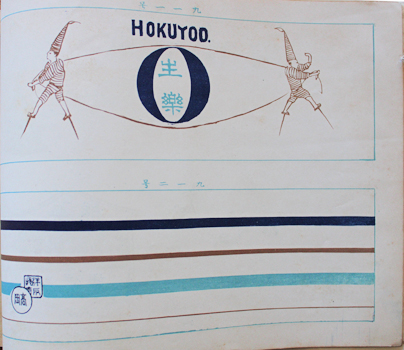
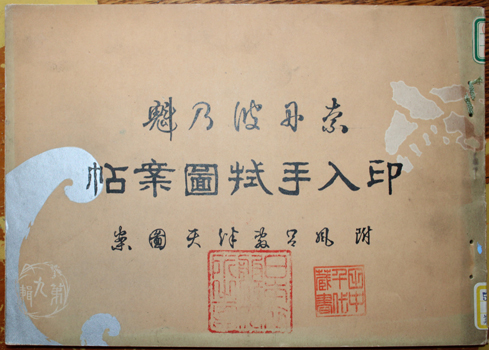
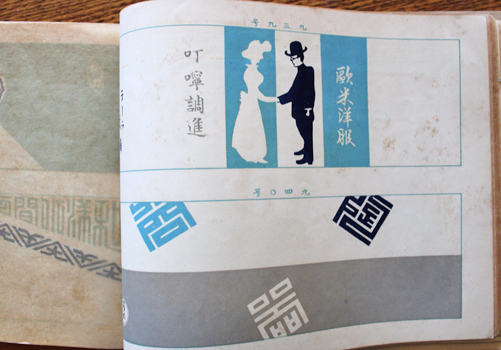
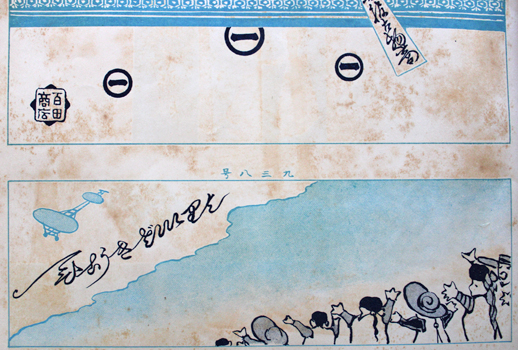
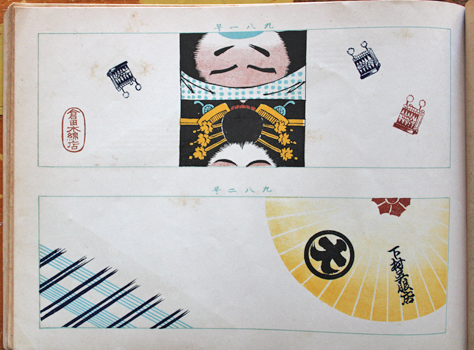
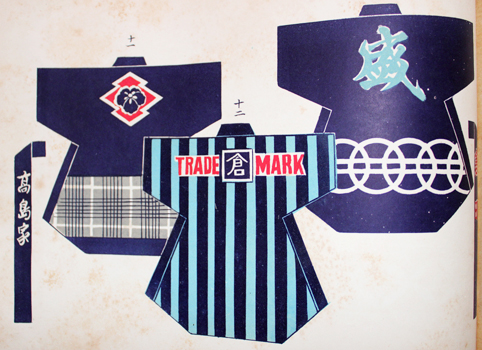

Catalogue - tenugui. なにはの魁 : 印入手拭図案帖 [Naniwa no Sakigake : Iniri Tenugui Zuanjo?] Osaka, Kurata Momenten 1912 (Taisho 1). 19x26cm publisher's printed wrapper; 100 tenugui designs printed two a page in two or more colours, 16 furoshiki (gift wrapping cloth) designs and a dozen banten (workmen's decorated jackets) designs. Signs of use, browning mostly of the wax tissue guards and a corner torn from one leaf touching one design. sold
Something as useful and universal as a tenugui - hand towel, or more precisely hand wipe - was never going to be some prosaic rag and so it became an aesthetic statement, a corporate logo, a gift, wrapping, a souvenir, and plain old sweatband.
Companies like Kurata Cotton offered a plenitude of designs and businesses would have their own details added. This is number 9 of Kurata's catalogues of tenugui patterns. I found a record of their 1903 and 1906 catalogues in Japanese libraries and nowhere else.
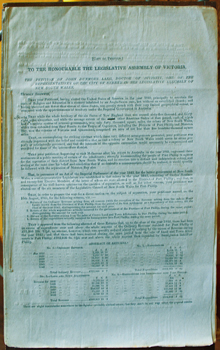
LANG, John Dunmore To the Honourable the Legislative Assembly of Victoria, the Petition of John Dunmore Lang ... Sydney, printed by Francis Mason 1861. Foolscap; 14pp on blue paper. An ink correction to the first page. Au$80
Lang's petition to Victoria to recognise or reward him for creating the colony of Victoria in the 1840s, backed by copies of his speeches, petition to the queen and report on the celebratory ceremony in 1846.
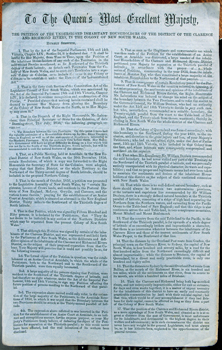
Secession - Northern New South Wales. To the Queen's Most Excellent Majesty, the petition of the undersigned inhabitant householders of the district of the Clarence and Richmond Rivers, in the colony of New South Wales ... n.p., dated in print Sept 1860. Foolscap sheet; two pages on blue paper. Au$75
A rankling problem for the inhabitants of northern New South Wales - and for most of Australia - the sense of being too far from the centre of power, influence and government spending. These petitioners felt they would do better as part of newly formed Queensland and ask that the colony's boundary be changed to include them. The locals continued resentful for some time and the move to join Queensland or form a new state altogether - there was a serious push for this in 1920 - resurfaced a few times.





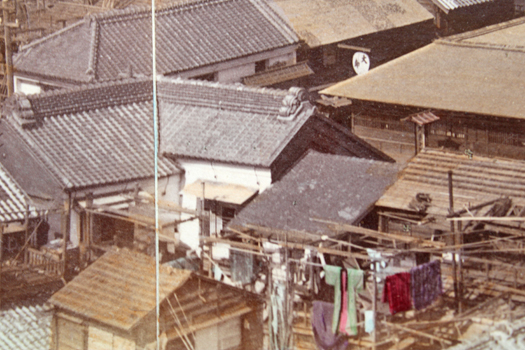

Yokohama. Handcoloured photo panorama of Yokahama. np c1890? Two albumen prints joined, 20x50cm, folded and mounted on an album leaf. Excellent clear prints with subtle colouring. Au$600
Yokohama became the western capital of Japan - westerners in Nagasaki were confined in numbers and location - and the Bluff - now Yamate - where the diplomats and wealthy built their mansions was the obvious spot for making a panorama of Yokohama. A gathering - small as it is - of them from the 19th and early 20th centuries might be a useful guide to the growth of the city: they are taken from spots very close to each other.
Of course it was a city that ceased to exist in 1923.





Catalogue - books. Aoki Suzando. 内外書籍 出版発兌目録 [Naigai Shoseki Shuppan Hatsuda Mokuroku] Aoki Suzando 1903 (Meiji 36). 11x16cm publisher's colour printed wrapper; 316pp. Natural browning of the paper, an old fold; a rather good copy. Au$65
Aoki Suzando was a busy and bigtime publisher of prints and bookseller with shops in Osaka and Tokyo from the late 1870s to the early 1920s. These are illustrated on the back wrapper.
I have no idea how many thousand books are in this catalogue of domestic and foreign books but it must be a pretty good indication of what was available in late Meiji Japan.
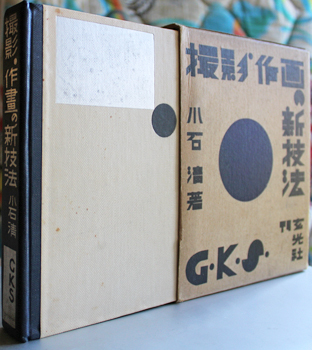
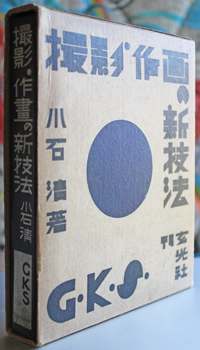
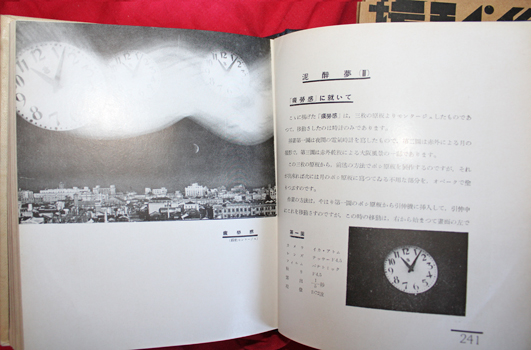
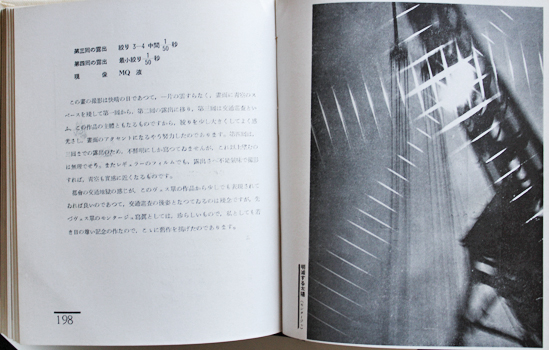
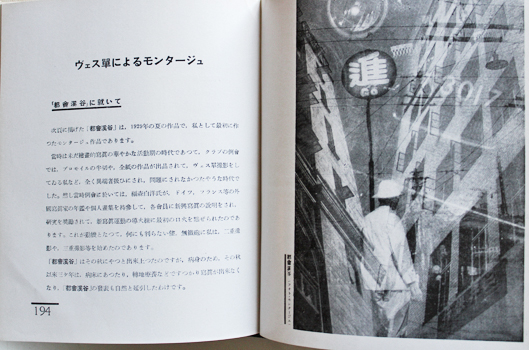
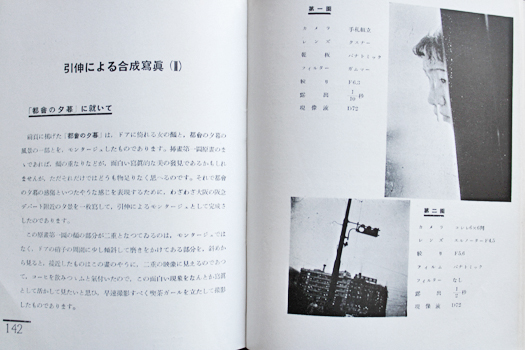

Koishi Kiyoshi. 撮影・作画の新技法 [Satsuei, Sakuga no Shingiho]. Tokyo, Genkosha 1936 (Showa 11). 20x16cm publisher's decorated cloth and printed card case; b/w photo illustrations and diagrams throughout. A few small spots on the cream front cover; a fetching copy. Au$2000
First edition of Koishi's new techniques of photography - double exposures, under exposures, over exposures, montage, photograms, asymmetry ... all the tricks of a determined modernist.
Onchi Koshiro designed this book. He designed several of Genkosha's photography books including, I presume, his own, and usually made them open right to left.





新撰唱歌のふきよせ [Shinsen Shoka no Fukiyose]. n.p. n.d. [c1880?] 18x12cm publisher's colour woodcut wrapper; 10 double leaves (20pp); b/w woodcut illustrations throughout. Rather good. Au$125
A rare and charming songbook, apparently for children, which has a look of long tradition. But if these are proper shoka then it is a form of school song that began with Meiji reformation of education. The subjects are in any case thoroughly up to date: balloons, steamships and photographs.
None of these songbooks are going to be common. I found an entry for what might be the same book in the Ryukyu University catalogue; nothing else.
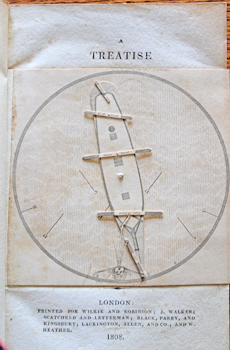

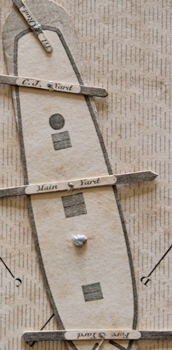

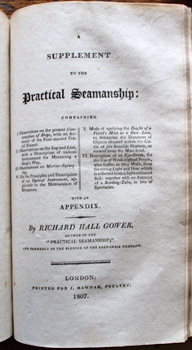
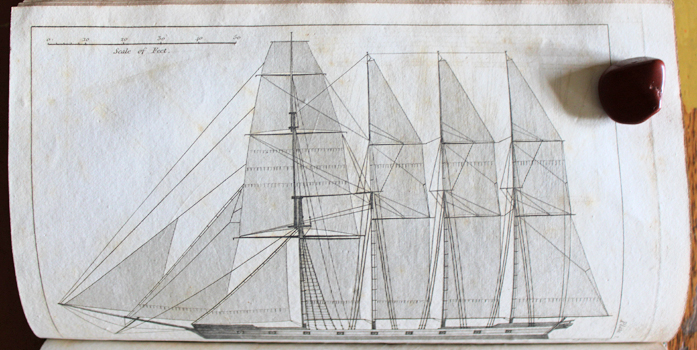

GOWER, Richard Hall. A Treatise on the Theory and Practice of Seamanship, together with a system of naval signals .. a useful compendium to the officer, to instruct him when young, and to remind him when old. The third edition, corrected and enlarged. [bound with] A Supplement to the Practical Seamanship ... London, for Wilkie & Robinson &c 1808; London for Mawman 1807. Octavo contemporary calf (rebacked, original lettering piece retained); xxviii,242,[2]pp; volvelle and ills and diagrams through the text; [4],208pp; seven plates - numbered to six with two fours - and illustrations through the text. Au$1300
Probably the last edition of the Treatise. The volvelle is particularly marvellous: a revolving ship in plan, on it a moveable jib (stayed with cotton), fore yard, main yard, C.J. yard and tiller/rudder; in a printed circle 120mm in diameter. The author's preface to this third edition reminds us why these books are so scarce: "the author having seen impressions of the former editions of this work, in the possession of young men on shipboard, many of which impressions had been deprived of their plates altogether, by rough sea-usage, and too intimate an aquaintance with the lee-scuppers - has, in part, prevented the evil in the present edition, by introducing the explanatory figures with the letter-press."
His preface to the second edition is a list of complaints about Steel's "Rigging and Seamanship", not so much for his piracy from Gower as for the misrepresentation and obfuscation introduced in his attempt to disguise that piracy.
The Supplement is Gower's continuing research, experiments, designs and inventions: his quite radical ship 'Transit', his new patent log, an eyeshade ... many of which were not much noticed but bore remarkable resemblances to improvements made later by others. Gower seems to have been an admirable man; clever, learned, always inspired by notions of progress, improvement and humanitarianism, and indefatigable in pursuit of acknowledgment and adoption of his work. I get the impression that the halls of power emptied at news that Gower was in the building.
Burnley said, in his DNB entry for Gower, that a second edition of the Supplement appeared in 1810 but I am yet to find a copy. The Treatise is hard to find, the Supplement is rare.

HILL, Headon. Unmasked at Last. NY, Fenno [1907?]. Octavo publisher's illustrated ochre cloth; frontispiece and two plates. A bright copy. Au$165
First American edition, soon after the English. An imprisoned counterfeiter's son is taken on as assistant gamekeeper by a thorough blackguard with a mysterious French master. But nothing is as it seems ... to start with, is the counterfeiter's son a counterfeit?





Yanagawa Shunsan. 西洋時計便覧 [Seiyo Tokei Benran]. Tokyo, Yamatoya Kihee 1872 [Meiji 5]. 185x80mm publisher's stiff wrapper with title label (marked), accordian folding to form 34pp with woodblock illustrations throughout. Rather good. Au$500
An introduction to the western watch and its workings and - more important - western time and how to tell it. Roman numerals and the hour, minute and seconds hands are explained and a series of watch faces guide us through the rest of the intricacies of measuring time in the western style. Obviously for the sleeve or pocket, this could be hauled out with the new gizmo when its fledgling owner was stumped. Or even by a non-watch owner faced with a public clock. At the end the thermometer is illustrated and explained too.
This is not to say that the Japanese hadn't already mastered the clock. Since the Jesuits introduced clocks in the 16th century Japanese clockmakers had developed complex weight and spring driven mechanisms to run timekeepers according to the unequal hours of day and night, varying according to season. But in 1872 the government switched from the lunar calendar to the solar calendar and abolished traditional timekeeping and a whole nation had to start again from scratch.
Makes sense to me that daylight hours are longer and night hours shorter in summer and the reverse in winter. We all know that despite what the clock says all hours are not created equal. Bring back traditional Japanese timekeeping I say.
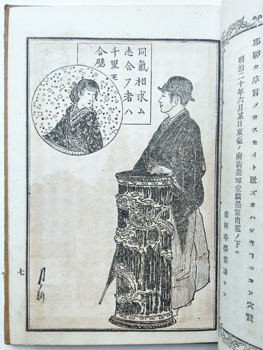
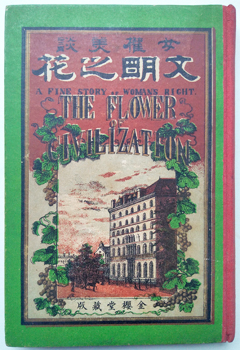
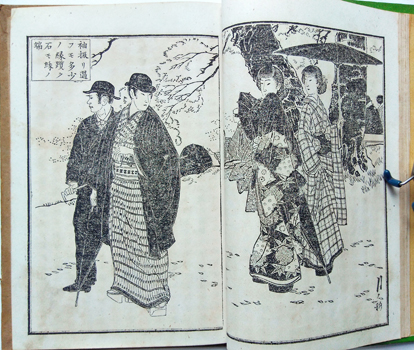
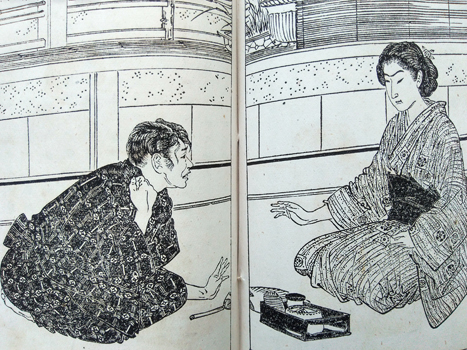

Sugiyama Tojiro. 文明之花 [Bunmei no Hana] A Fine Story of Womans Right - the Flower of Civilization [cover title]. Tokyo, Kin'odo 1887 (Meiji 20). Octavo (19x13cm) publisher's colour illustrated boards and cloth spine; two single page and four double page illustrations. Less than expected browning of the paper here and there and minor signs of use. A near splendid copy. Au$1200
First edition of this remarkable utopian novel of women's rights in which a couple work towards and see the establishment of two equal parliaments, one for women and one for men. This was written in the period of anticipation of Japan's first parliament, scheduled for 1890. Radical as Sugiyama was, there is a sting in the tail for current feminists: Sugiyama is clear that women should be equal to men in all things right up until they get married. Equality for men and women does not mean equality for husband and wife.
Sugiyama published a rush of novels and political writing in the late seventies and eighties. These days he has been exhumed and is kept busy being rediscovered as a science fiction writer.
I've discovered that two completely different covers exist: one, prettified, with a mock cabinet photo of a young woman against a floral background and this one, a solid western building in a modern city street. To capture the serious male reader who would not pick up what might be a romance for women?
This is a 'ball cover' (boru hyoshi) book - a signal of modernity and the Japanese equivalent of a yellowback: flimsy western style bindings with lithograph covers that rarely survive in such good shape.
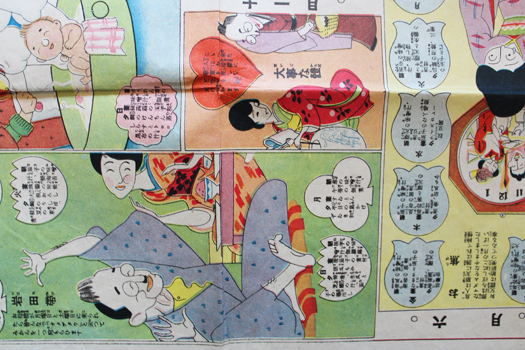
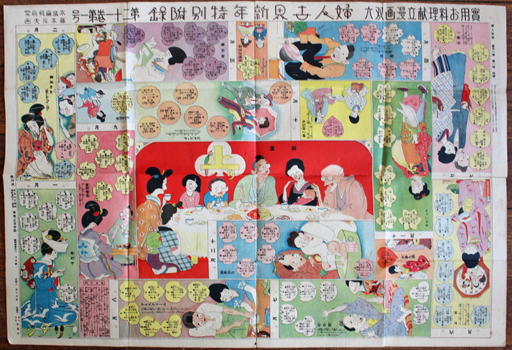
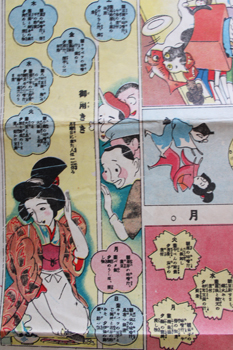

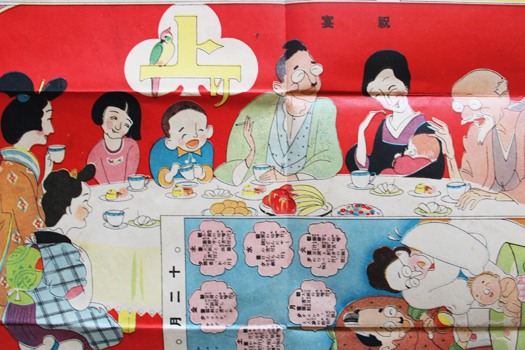

Fujimoto Katao. 実用お料理献立漫画双六 [Jitsuyo Oryori Kondate Manga Sugoroku]. Tokyo, Fujin Sekai 1926 (Taisho 15). Colour broadside 55x79cm. A bit used, a small hole in one margin, a short repair in another; not a bad copy. Au$250
This delightful manga sugoroku celebrates cooking and was the new year gift from the magazine Woman's World.




Hikifuda 各國大醫之有効保証樂 : 百毒下し : 和順湯 [Kakukoku dai i no yuko hoshoraku? Hyakudokukudashi : Wajanyu]. c1900? 40x50cm colour woodcut. Au$150
A singular and baffling, to me, handbill or hikifuda for a patent medicine for women that expelled a hundred poisons and cured ailments that any woman was likely to suffer.
It's the character in the corner that stumps me. Since I can't read the text I have no idea who he is nor what he is doing. My first guess is that he is threatening to tie the young woman to the railroad tracks but I'm sure this predates any American film serials that could have arrived in Japan. So is he a traditional stage villain or does he do something else in Japan? Surely he isn't one of the many great foreign doctors who guarantee Wajanyu or Heshun Tang, which seems to be a traditional Chinese medicine. But ... he is ordering her and us to pay attention.
According to Ernest Clement, in a 1907 article on medical folk-lore in Transactions of the Asiatic Society of Japan, in 1896, in Tokyo alone, there were 1401 registered inventors of patent medicines, 5145 vendors, 42,533 quack doctors and 5137 qualified medicos.
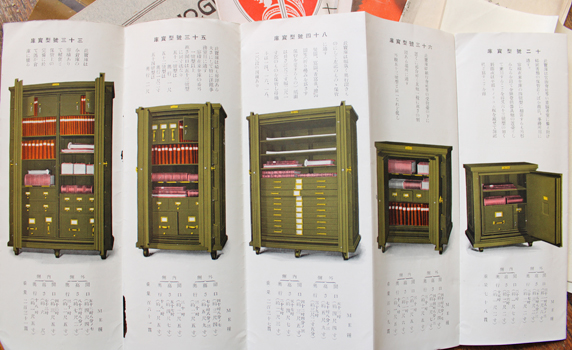
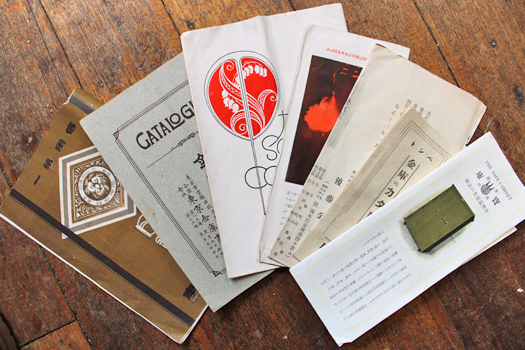
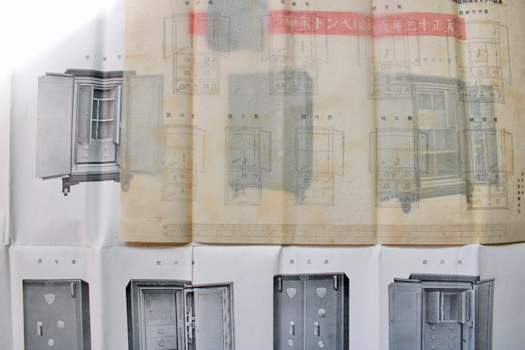
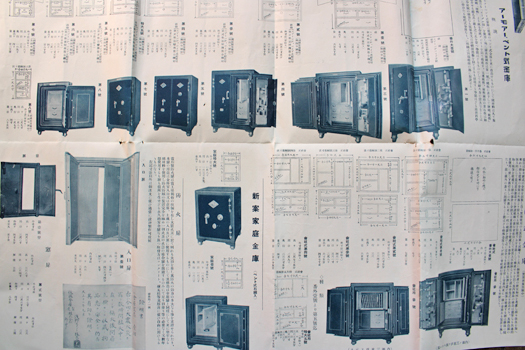
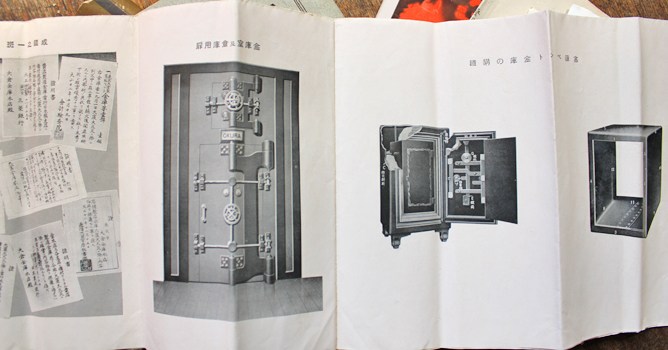
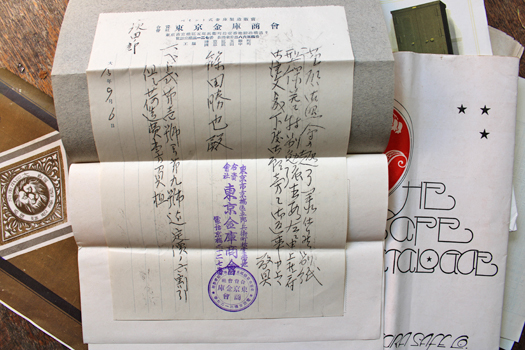

Catalogues - safes. Seven illustrated catalogues or brochures for Japanese safes. vp [1924?]. various sizes between 18 and 24cm high, a couple folding out to fairly large sheets; one with colour illustrations, the rest monochrome. A couple of small nibbles, rather good. Au$200
Safe catalogues are hard to find. Here is what appears to be a representative collection of Japanese safe manufacturers in the year 1924 - four of these are dated. Include are the Goto Safe Company, the Okura Safe Company and Tokyo Safe Company.
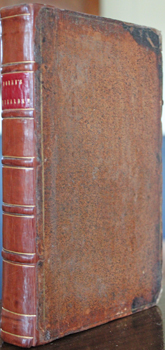

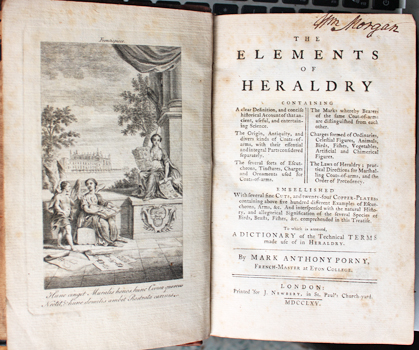
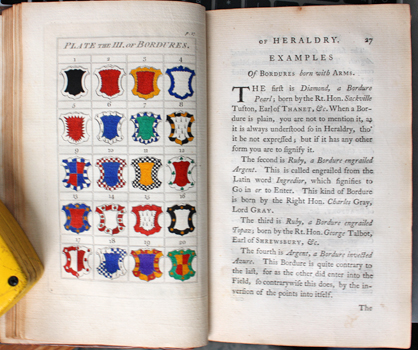

PORNY, Mark Anthony. The Elements of Heraldry. Containing, a clear definition, and concise historical account of that ancient, useful, and entertaining science ... annexed a dictionary of the technical terms made use of in heraldry. London, Printed for J.Newbery, 1765. Octavo contemporary speckled calf (rebacked, corners worn); xx,199,[4]pp, engraved frontispiece and 23 plates. Some spotting or browning but nothing serious. A charming copy with twelve plates neatly and correctly handcoloured. Au$125
First edition, at least four more appeared over the next few decades.
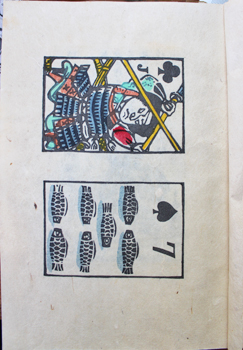

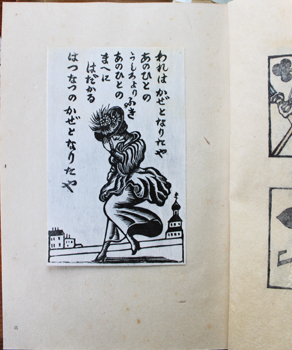
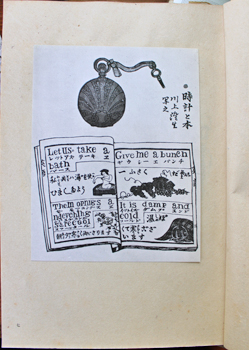
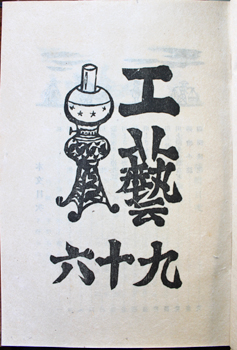

Kawakami Sumio. 工藝 96巻 [Kogei no.96]. Tokyo, 1939 (Showa 14). 23x15cm publisher's illustrated wrapper; woodcut and enamel on the cover, [4], colour woodcuts on two leaves, mounted photo plates on 17 leaves, 64pp of text with small illustrations, publisher's adverts. A nice copy in original wax paper wrapper. Au$200
This issue of Kogei (craft) is devoted to Kawakami. His work is charming, simple to the point of naive so of course it isn't. Kawakami nursed a nostalgia for a time he did not experience. I'm sure there's word for that which isn't nationalism, xenophobia or popularism. In his case it was the printed Meiji enlightenment and the confusion of westernisation that fascinated him and it is easy to see the models of early Meiji primers for children in his prints.
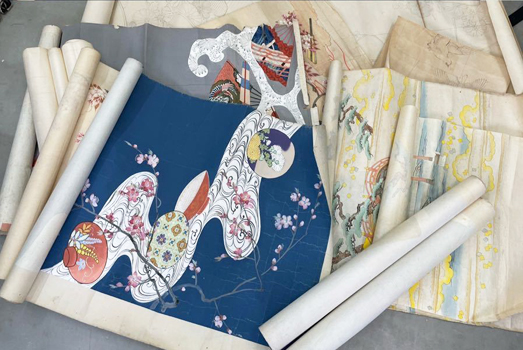
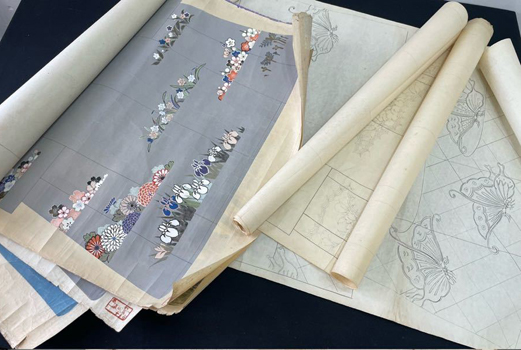
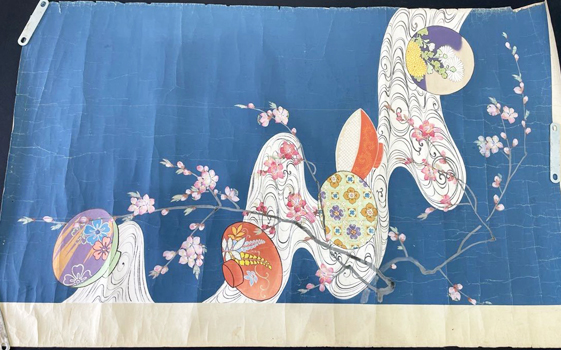

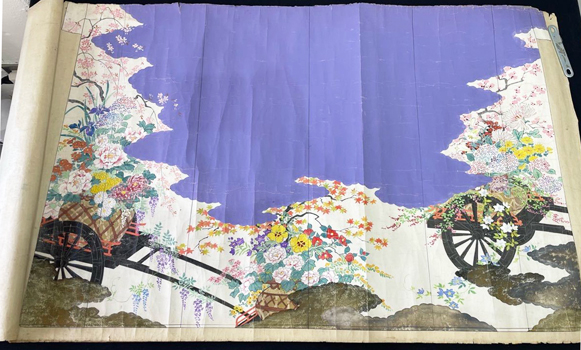
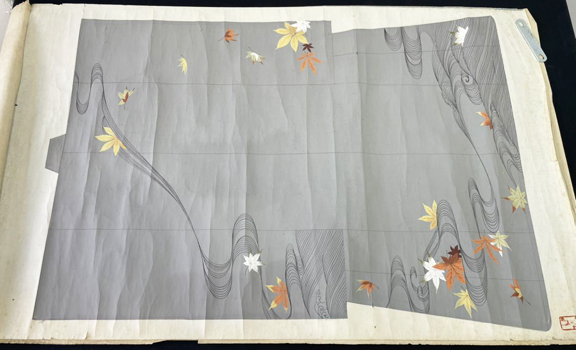

Japanese textiles. A bundle of 20 extra large original designs for kimonos. n.p. first half of the c20th. Twenty designs in pencil, pencil and ink or water colour, 12 are coloured, the rest are line drawings. All are about 70cm wide and range in length between 90cm and 170cm. All show signs of use, a few quite rumpled, one quite ragged, but all complete and perfectly useful. A few with stamps I read as Iwamoto Rokunosuke of Kyoto and a scattering of inscriptions and seals on others. held
These are too flowery for me but much of the world will disagree. A fairly remarkable group for their scale and for being thoroughly professional working drawings that have survived.
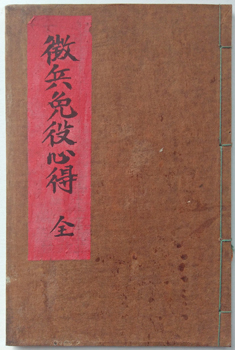

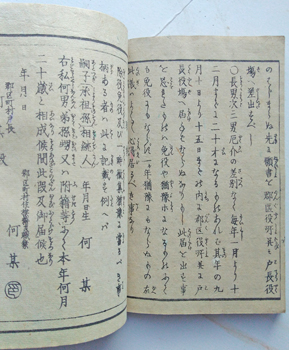

The draft dodger's handbook
Inaba Eiko. 徴兵免役心得 [Chohei Men'eki Kokoroe]. Osaki Naosaburo 1879 (Meiji 12). 17x11cm later wrapper with manuscript title; illustrated title/self wrapper and eight leaves. An excellent copy. Au$500
The guide to exemptions from conscription into the new Imperial Army. Conscription rolled out slowly across Japan from 1873 and one of the most useful exemptions was being a first son; which meant a rash of adoptions preferably into a family where conscription hadn't yet arrived. Fukuzawa wrote about "sons who do not know where their fathers live" and I read somewhere that one of Japan's great literary heroes - Soseki maybe? - registered himself in Hokkaido to escape the draft.
Of course money solved everything: an exemption or proxy fee meant that someone else took your place and I would guess that no true aristocrat would dream of having a son drafted; they were already in military school and officer training. So, naturally, peasants filled the draftee ranks and not all peasants were happy about this. There were 'blood tax' riots, the most furious in Okayama where authorities adroitly charged 20,000 rioters, executed a dozen or so and gaoled a few dozen more.
Without money, a good solid disease, disability or an affable sonless family this little pamphlet was your best friend. Worldcat finds no copies and CiiNii finds one, at Tokyo University. It's often cited by academics but as they mostly repeat each other's mistakes I doubt many have seen it.
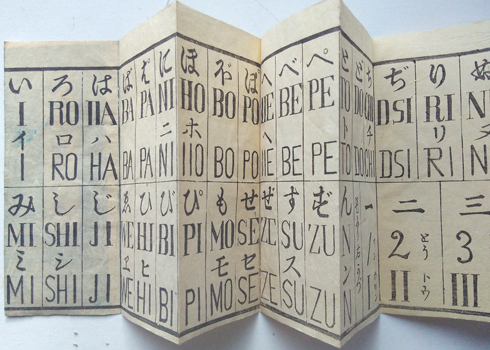

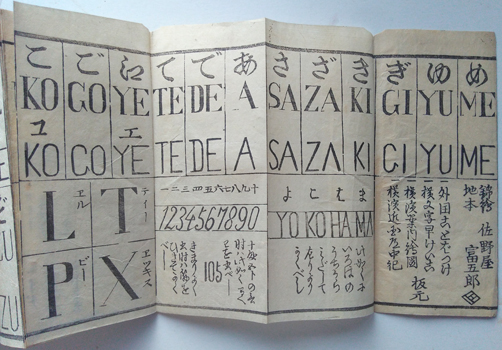

横文字いろは - 早けい古 [Yokomoji Iroha - Haya Keiko]. Yokohama? Sanoya Tomigoro [c1870?]. Woodcut on four joined sheets that folds from 15x7cm out to 130cm. Decorated title panel printed in blue and black, last blank panel with several small red stamps reading Naga (長) and one Nagata (長田). An outstanding copy of something pretty well guaranteed not to survive second or third uses. Au$600
A captivating pocket or sleeve guide to horizontal writing with some numbers thrown in - Roman numerals for reading clocks - the latest of what must have seemed an endless array of challenges to life in Meiji Japan. Iroha might be translated into English as ABC.
Sanoya Tomigiri was a print publisher who moved from Tokyo (Edo) to Yokohama when it opened to the west and where he also became a singer. He is known as the publisher of prints by Yoshitoshi and at least four of the Utagawas, maps, guides and handy educational things like this.
I found a reference to something with almost this title printed by him at the beginning of the Meiji but it isn't the same thing, not even close. There may be another copy of this somewhere but I haven't found it.
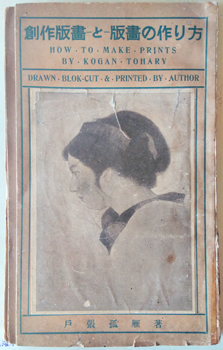

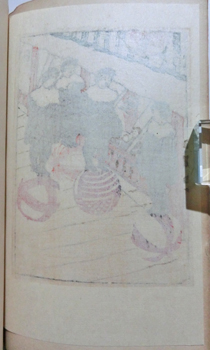
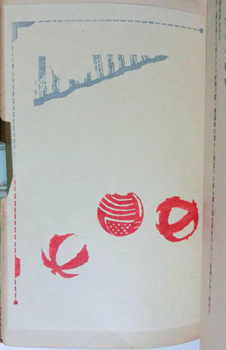
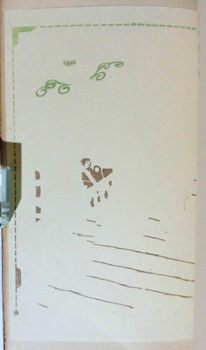

Tobari Kogan. 創作版画と版画の作り方 [Sosaku Hanga to Hanga no Tsukurikata] How to Make Prints by Kogan Tohari : Drawn, blok-cut & printed by author [sic]. Tokyo, Hangasha 1922 (Taisho 11). 21x14cm publisher's printed card wrapper with mounted illustration (wear to spine with an old tape mark, stain on the back, other signs of use); 10 mounted b/w photo illustrations, one b/w illustration and six mounted woodcuts, being three blocks with five colours, the key block in black, the complete print all in black, and the finished colour print. A somewhat dishevelled cover but not bad; mild browning, all rather good and fresh inside. The wrappers look like they have been cut back from the page edges but they are folded and that's how the book was issued. Au$2500
An idiosyncratic book printed on tan stiff card which, while browned, is not as browned as it might appear in photos. The prints themselves are crisp and bright. The half-tone illustrations do Tobari's work no favours but I guess they gave some vague indication of his work. He produced so few prints that more than half of them are here.
Tobari has made for this lesson a smaller version of his mysterious print of acrobats: is it political commentary? religious? all just show biz? He was a founding member of the sosaku hanga - creative prints - movement which cut all and any middle men between the artist and final print. I'm embarrassed to admit that I knew nothing of him until recently when I watched three of his prints that I admired and coveted - one of them the acrobats - sell for a few tens of thousands of dollars. So I have learnt that he is hardly a well kept secret but I haven't learnt much about him except that he studied and caught TB in America and was established as a Rodinesque sculptor before turning to print making and that he died youngish, in 1927. He didn't have time to become a grand old man of art like his colleagues Koshiro Onchi, Maekawa Senpan and Kawakami Sumio. Onchi was dismissive of, almost venomous about, Tobari in his 1953 book on modern prints. Tobari was too technically skilled and too emotional and Onchi, for all his achievement, could not produce the exquisite and moving portrait represented by the grey blur on the cover of this book.
This is pretty rare; Worldcat finds only the V&A and BL entries outside Japan.



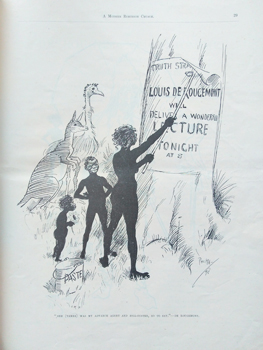

Louis de Rougemont. Grien on Rougemont; or, the story of a modern Robinson Crusoe. As told in ... the Daily Chronicle. Illustrated by ... Phil May, and other pictures. London, Edward Lloyd 1898. Slender folio later half crushed morocco by Morrell, with publisher's colour illustrated wrapper bound in; 34,[2 advert]pp, illustrated throughout.
This had seen some life before being bound and there is an old fold and minor signs of use. An unexpectedly luxurious copy that must have cost more to bind than one would have thought a replacement could be found. Obviously never a common book. With the bookplate of Henry L. White. Au$500
Louis de Rougemont (ie Henri Grien) exposed and ridiculed while his Adventures were still appearing in the Wide World and before his book appeared. This compilation of condemnatory evidence gives something of his true history and seemingly sad life in Australia. Appended is a short pantomime sketch by that so called Barry Pain.
Inserted are two clippings about his miserable state in 1920 and his death in 1921.
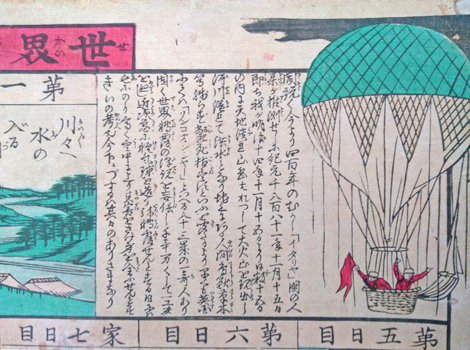

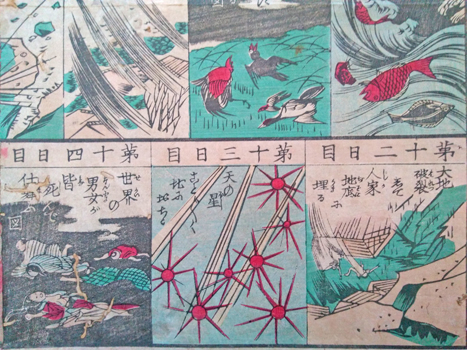
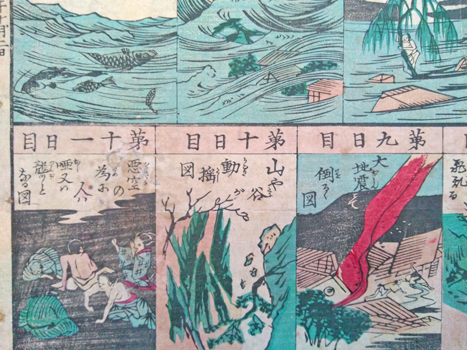
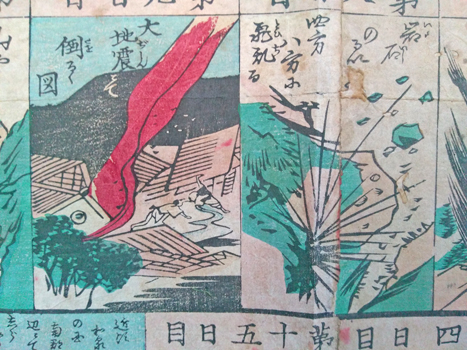
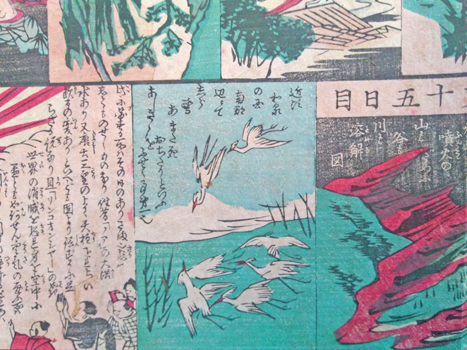

Mother Shipton in Japan
End of the world. 世界転覆奇談 [Sekai Tenpuku Kidan]. Fukutaro, October 2nd 1881 (Meiji 14) Colour woodcut on two sheets 36x49cm. Some splodges, professional repairs to wormholes, not bad. Au$1200
Mother Shipton in Japan and the end of world over 15 days. Word somehow spread, at the time of a series of natural disasters, that some 15th century westerner had prophesised the end of the world in 1881 and it looked very much like it was happening. I can't find any indication that Mother Shipton has been identified in Japan but she must be our culprit. Or rather, since Mother Shipton's prophecies only began appearing a century or so after her death, supposing that she did exist, in this case the blame lies with Charles Hindley, hack antiquarian and bibliographer, who published an authentic version of her prophecies in 1862 which included the 1881 prophecy and, in 1873, confessed that he made it up.
A chilling sort of butterfly effect, in that an amusing jape in Brighton, England ends up apparently causing despair and suicides in Japan twenty years later. What is curious is that these prints and pamphlets are labelled a 'delusion' of the end of the world but this did not stop despair and it certainly didn't affect the sales of all these prints. Fujimoto* quotes from a 1925 interview with someone who remembered the fuss and spoke of crowds in the print shops every day and the rising number of suicides. I gather the authorities lost patience and cracked down pretty quick. Naturally all those books and prints have pretty much vanished.
*This print is no.8 in a deduced list of 19 items put together by Naoki Fujimoto for an article on the delusion in a 2010 NDL newsletter. Quite a few of those were listed as unseen. He locates a copy of this print at Tokyo University and Tokyo Museum has a copy. That's all I could find. Waseda has a similar print but in a different format published by Hirano Denkichi a few days earlier.
I gather the balloon is carrying a couple of English balloonists fleeing the country but I'm not clear which country.



Wakefield, Edward Gibbon. Facts Relating to the Punishment of Death in the Metropolis. London, Ridgway 1831. Octavo, uncut in original boards (neatly rebacked); xii,198,[2 advert]pp. A crisp copy. Au$900
First edition. Parents of underage heiresses may have wished Wakefield hanged but he wasn't in any great danger in Newgate. So he was able to become a good example of his own precept - that it was certainty rather than severity of punishment that works: he never kidnapped another wealthy teenager.
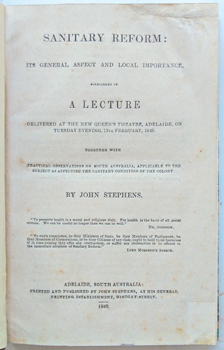


STEPHENS, John. Sanitary Reform: its general aspect and local importance, considered in a lecture ... Adelaide, printed & published by Stephens 1849. Octavo modern quarter crushed morocco by Bayntun-Riviere; viii,64pp and a number of blanks for bulk. Small repairs to the corners of the title page. Au$500
It seems that subscribers to the South Australian Register and the Adelaide Observer got copies of Stephen's three hour lecture whether they wanted or not: Stephens was the editor and owner of both. Still, it's quicker to read than hear.
And still, this is solid pioneering sanitary reform with plenty of evidence that the poor die faster, younger and more often than the well to do by magnitudes, and that legislation is urgently needed. Adelaide was, after all, "litterally living on a dunghill of thirteen years' standing." Stephens was a dedicated trouble maker whose presses had been seized the year before, gathered eight libels suits in this year - though he was mostly off sick - and died the next year.
A glance at Worldcat and Trove would convince you that there are plenty of copies of this, until you start weeding out the facsimile printing.



Hikifuda. 綿ネール雑貨商 [Wata Neru Zakka-Sho]. 1906 (Meiji 39). Colour lithograph 38x26cm. sold
I'm sure this insufferable couple are appalled to find they are advertising cotton, nails and general merchandise. I suspect that picture behind them is the view through their stateroom window. They must have thought they would showcase luxury travel and travel goods.
Hikifuda - small posters or handbills - were usually produced with the text panel blank. The customer, usually a retailer, had their own details over printed, so the same image might sell fine silk or soy sauce.
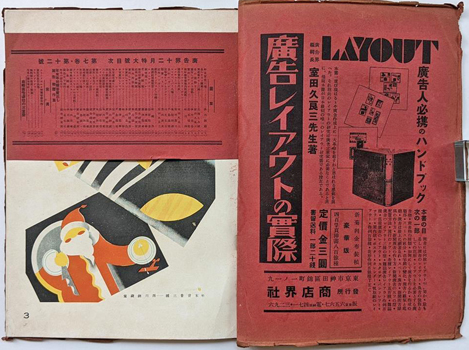
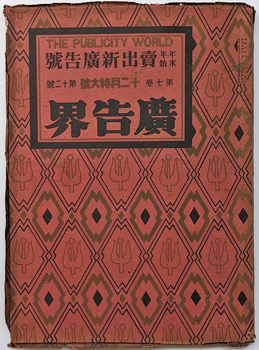
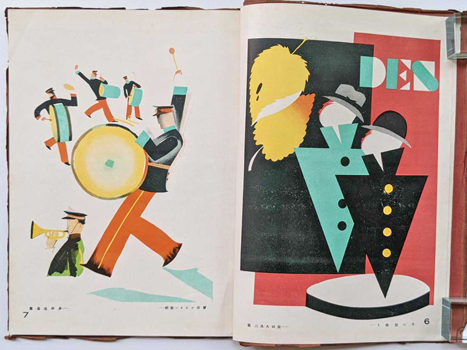
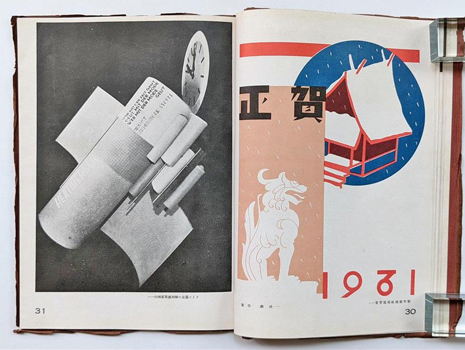
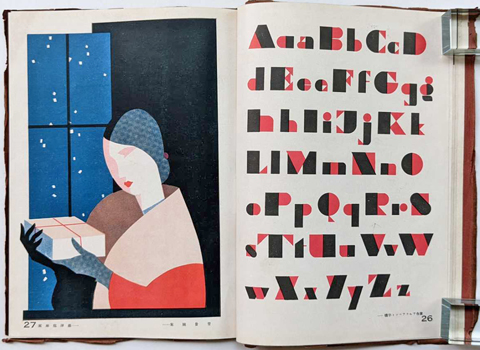
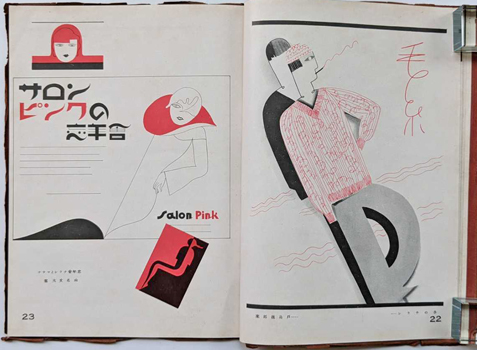
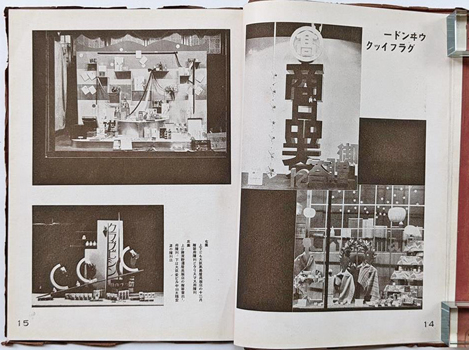

Advertising. 廣告界 - 第七巻第十二號 [Kokokukai : Publicity World - vol 7 no12]. Seibundo, December 1930. 26x19cm publisher's decorated wrapper; pp3-94; illustrated throughout, several pages in colour. Don't be alarmed by the pagination: the contents leaf is a slip printed on red paper inserted at the front and the first entry is the colour plate on page three. sold
The special Christmas number of Publicity World for 1930, with extra colour and movement. A panoply of up to the minute Japanese and European advertising from typography to window dressing; photo montage to the ever reliable skirt blowing in the wind.